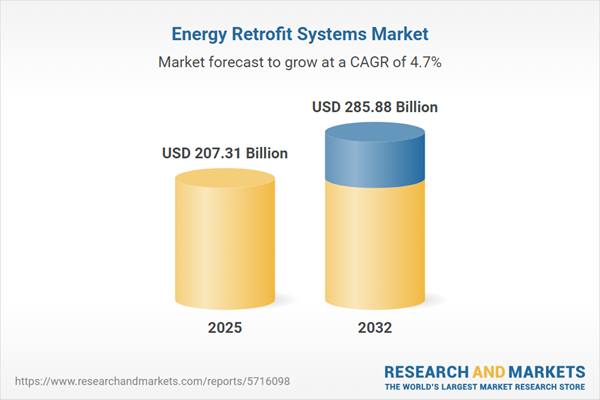Speak directly to the analyst to clarify any post sales queries you may have.
The energy retrofit systems market is a priority for organizations seeking sustained operational resilience and compliance with evolving regulations. Senior decision-makers are increasingly investing in sector-specific solutions designed to optimize facility performance, adapt to new sustainability standards, and support future-ready operations.
Market Snapshot: Energy Retrofit Systems Market Performance
The global energy retrofit systems market recorded robust growth in 2024, reaching a valuation of USD 198.08 billion. This expansion reflects a dynamic environment where organizations pursue innovative retrofitting technologies and systematic facility upgrades. The momentum is driven by the need for heightened energy efficiency and the demand for compliance with complex regulatory frameworks. Leaders identify digital retrofits and the integration of advanced facility management tools as core pathways to reinforcing agility and ensuring organizations can respond rapidly to shifting operational and policy landscapes.
Scope & Segmentation of the Energy Retrofit Systems Market
This comprehensive market report provides detailed segmentation and actionable insights designed to help senior leadership direct investments, source procurement efficiently, and execute modernization initiatives across broad asset portfolios in varying regulatory environments.
- Product Types: Includes solutions for building envelope upgrades, the installation of advanced HVAC systems, updated lighting protocols, cutting-edge insulation, roofing enhancements, wall structure improvements, and the adoption of fenestration technologies. Renewable energy solutions such as solar, geothermal, and wind integration are also addressed for organizations pursuing sustainability benchmarks.
- End Users: Covers commercial, industrial, institutional, and residential segments. Each end user experiences distinct modernization and compliance pressures, necessitating tailored retrofit strategies based on unique asset usage patterns and operational goals.
- Technologies: Encompasses IoT-enabled sensors that offer real-time asset monitoring, the deployment of advanced analytics for predictive maintenance, and new insulation materials that sustain structural integrity within diverse building portfolios.
- Retrofit Depth: Addresses both comprehensive infrastructure renewal projects and phased or scoped upgrades. This lets organizations align update depth and timelines with budget priorities and anticipated return on investment, offering flexibility in strategic planning.
- Geographic Regions: Considers opportunities and adaptations for the Americas, Europe, Middle East & Africa, and Asia-Pacific. Regional segmentation enables leaders to align strategies with local regulations, technology adoption, incentives, and differing levels of digital infrastructure maturity.
Key Takeaways for Senior Decision-Makers
- Integrating retrofit system planning into broad capital allocation strategies enables organizations to strengthen operational resilience amid expanding regulatory demands and shifting sustainability expectations.
- The implementation of data-driven sensors and analytics promotes proactive facility management, deepening visibility into asset performance and supporting transparency in compliance adherence.
- Financing models including energy-as-a-service options and performance-based contracts allow organizations to synchronize capital outlays with operational value, while providing greater control over risk in retrofit projects.
- Addressing regional policy variations and leveraging available market incentives help ensure consistent compliance, support smarter asset deployment, and maximize long-term value across sites.
- Ongoing research collaboration and focus on innovation equip organizations to stay ahead of regulatory change and to sustain the effectiveness of investments in retrofit solutions across diverse operational environments.
Tariff Impact on Supply Chains and Costs
Recent tariff actions affecting key retrofit system components in the U.S. have created cost and procurement challenges. Senior leaders are responding by diversifying supply chains, securing agreements with longer durations, and incorporating modularity into system designs. These strategies help shield modernization efforts from market volatility and reduce the potential for project delays, ensuring continuity even when sourcing conditions fluctuate.
Methodology & Data Sources
Findings are developed from a blend of primary and secondary industry data, reviews of current regulatory requirements, and direct feedback from procurement executives. This ensures recommendations reflect actual market practices and the operational complexities encountered during adoption.
Why This Report Matters
- Equips senior executives with precise market segmentation and intelligence, streamlining procurement and risk-management decisions and strengthening supplier selection and investment processes.
- Clarifies the impact of regulatory, technological, and financing developments, enabling leadership to advance timely and effective modernization strategies.
- Supports the creation of responsive regional and partnership models, allowing organizations to quickly navigate global shifts in policy or market conditions while minimizing risk to ongoing operations.
Conclusion
Senior decision-makers will find clear, actionable guidance in this report to drive modernization, ensure compliance, and manage assets effectively with advanced energy retrofit strategies. This supports long-term adaptability and ongoing operational success amid a dynamic regulatory and sustainability landscape.
Additional Product Information:
- Purchase of this report includes 1 year online access with quarterly updates.
- This report can be updated on request. Please contact our Customer Experience team using the Ask a Question widget on our website.
Table of Contents
3. Executive Summary
4. Market Overview
7. Cumulative Impact of Artificial Intelligence 2025
Companies Mentioned
The companies profiled in this Energy Retrofit Systems market report include:- Schneider Electric SE
- Honeywell International Inc.
- Siemens AG
- Johnson Controls International plc
- ABB Ltd
- Emerson Electric Co.
- Eaton Corporation plc
- Trane Technologies plc
- ENGIE SA
- Veolia Environnement S.A.
Table Information
| Report Attribute | Details |
|---|---|
| No. of Pages | 186 |
| Published | October 2025 |
| Forecast Period | 2025 - 2032 |
| Estimated Market Value ( USD | $ 207.31 Billion |
| Forecasted Market Value ( USD | $ 285.88 Billion |
| Compound Annual Growth Rate | 4.6% |
| Regions Covered | Global |
| No. of Companies Mentioned | 11 |








